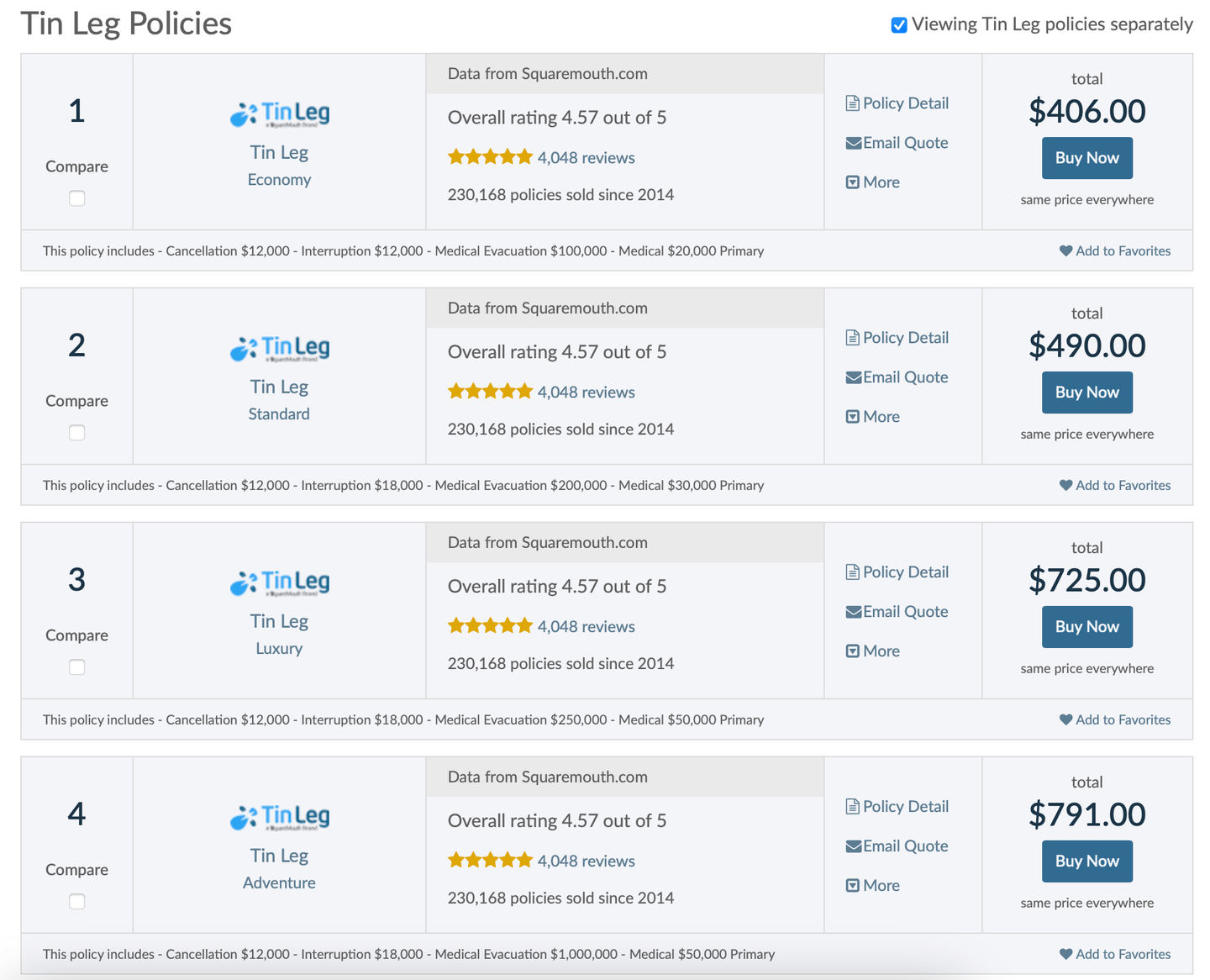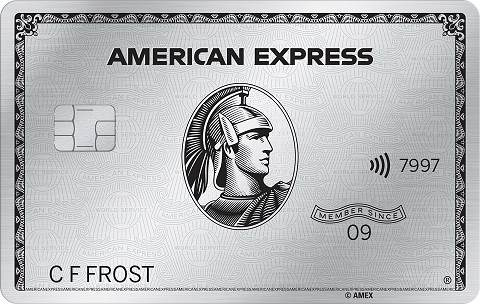Tin Leg Travel Insurance Review: Is it Worth the Cost?
Tin Leg offers nine different insurance policies of varying cost and coverage, so consider all your options.

Many or all of the products on this page are from partners who compensate us when you click to or take an action on their website, but this does not influence our evaluations or ratings. Our opinions are our own.
Table of Contents

Tin Leg
Pros
- In addition Cancel For Any Reason, some plans offer cancel for work reason coverage.
- Adventure sports-specific coverage is available.
Cons
- Plans have overlap that can be hard to distinguish.
- Claim approval can be lengthy.
- Only one plan includes Rental Car Damage coverage available as an add-on.

Tin Leg
Pros
- In addition Cancel For Any Reason, some plans offer cancel for work reason coverage.
- Adventure sports-specific coverage is available.
Cons
- Plans have overlap that can be hard to distinguish.
- Claim approval can be lengthy.
- Only one plan includes Rental Car Damage coverage available as an add-on.
Tin Leg offers lots of different plans to travelers and is priced far below its competitors, but its bare-bones options may not be the right fit for everyone.
Why trust NerdWallet?
Our Nerdy editorial team aims to be a starting point in your travel insurance research. We default toward transparency and follow a comprehensive methodology for rating and reviewing travel insurance companies. Advertisers and advertising relationships do not influence our ratings. Learn more about our strict editorial guidelines.
What is Tin Leg?
Tin Leg is owned by travel insurance aggregator Squaremouth, a company that sells insurance as well as compares policy prices. Squaremouth is a NerdWallet partner. It has three companies that underwrite its policies depending on which one you purchase:
Berkshire Hathaway Specialty Insurance Co.: AM Best rating of A++ (superior).
Starr Indemnity & Liability Co.: AM Best rating of A (excellent).
Spinnaker Insurance Co.: AM Best rating of A- (excellent).
AM Best is a company that ranks insurance companies based on their solvency and likelihood to pay out claims.
Vacation more, spend less. Subscribe to our free newsletter for inspiration, tips, and money-saving strategies – delivered straight to your inbox.
By signing up, you will receive newsletters and promotional content and agree to our Terms of Use and acknowledge the data practices in our Privacy Policy. You may unsubscribe at any time.
What does Tin Leg cover?
Tin Leg travel insurance coverage varies based on which policy you purchase. However, you’ll find Tin Leg health insurance coverage on all plans and benefits such as coverage for adventure activities on most plans.
Baggage insurance: Reimburses you for expenses incurred when your luggage is delayed or covers the cost of replacing lost items.
Trip cancellation and trip interruption: Covers you in the event your trip is canceled or interrupted due to a covered reason; repays nonrefundable trip costs.
Travel delay: Reimburses the cost of meals and accommodations when a trip is unexpectedly delayed.
Tin Leg travel insurance medical coverage: Pays for injuries and illnesses that occur during your trip.
Emergency medical evacuation: Covers the cost of moving you from one location to another to get appropriate health care.
Sports and adventure activities: Includes medical coverage even when you’re doing activities that are normally excluded.
Tin Leg policies
Trip cancellation | Trip interruption | Medical coverage | Luggage | |
|---|---|---|---|---|
Tin Leg Economy | Up to 100% of trip cost. | Up to 100% of trip cost. | $20,000 per person (secondary). | Up to $500 for loss, up to $200 for delay. |
Tin Leg Standard | Up to 100% of trip cost. | Up to 150% of trip cost. | $30,000 per person (secondary). | Up to $500 for loss, up to $200 for delay. |
Tin Leg Luxury | Up to 100% of trip cost. | Up to 150% of trip cost. | $100,000 per person (primary). | Up to $500 for loss, up to $200 for delay. |
Tin Leg Adventure | Up to 100% of trip cost. | Up to 150% of trip cost. | $100,000 per person (primary). | Up to $1,000 for loss, up to $200 for delay. |
Tin Leg Silver | Up to 100% of trip cost. | Up to 150% of trip cost. | $250,000 per person (secondary). | Up to $2,500 for loss, up to $500 for delay. |
Tin Leg Gold | Up to 100% of trip cost. | Up to 150% of trip cost. | $500,000 per person (primary). | Up to $500 for loss, up to $200 for delay. |
Tin Leg Basic | Up to 100% of trip cost. | Up to 150% of trip cost. | $50,000 per person (secondary). | Up to $500 for loss, up to $200 for delay. |
Tin Leg Platinum | Up to 100% of trip cost. | Up to 150% of trip cost. | $100,000 per person (secondary). | Up to $500 for loss, up to $200 for delay. |
Add-on options
Tin Leg offers a few add-on options, although they’re not available for every plan:
Rental car insurance.
Flight only accidental death and dismemberment (AD&D) coverage.
What’s not covered by a Tin Leg plan
All of Tin Leg’s plans are comprehensive, so you’ll have a base level of coverage no matter which one you buy. However, there are some exclusions that should be noted.
Named storms.
Acts of war.
Epidemics.
Intentional self-harm.
Reasonably foreseeable events.
Things you do while under the influence of drugs or alcohol.
How Tin Leg compares to its competitors
On a five-star scale, NerdWallet rated Tin Leg three stars. Although it’s inexpensive, the medical coverage on many of its plans is secondary, which means it’ll pay out only after other sources have made their payments.
Tin Leg also doesn’t offer much in the way of customizations, which may mean you end up forced to purchase a more expensive plan if the one you like doesn’t provide the coverage you need.
Company | Star rating | Basic plan cost | Premium plan cost | Generate a quote |
|---|---|---|---|---|
GeoBlue Travel Insurance | 4.5 NerdWallet rating | $10. | $18. | |
Berkshire Hathaway Travel Protection | 5.0 NerdWallet rating | $26. | $75. | |
Tin Leg | 3.0 NerdWallet rating | $36. | $188. | |
WorldTrips Travel Insurance | 5.0 NerdWallet rating | $47. | $66. | |
World Nomads | Currently being rated and reviewed. | $63. | $115. | |
Trawick International | 5.0 NerdWallet rating | $100. | $194. | |
AXA Assistance USA | 1.5 NerdWallet rating | $114. | $159. | |
Generali | 1.5 NerdWallet rating | $123. | $164. | |
Travelex Insurance Services | 4.0 NerdWallet rating | $135. | $198. | |
AEGIS (GoReady) Travel Insurance | 3.5 NerdWallet rating | $139. | $208. | |
HTH Travel Insurance | 4.0 NerdWallet rating | $146. | $233. | |
Seven Corners | 3.0 NerdWallet rating | $154. | $225. | |
Travel Insured International | 4.0 NerdWallet rating | $164. | $218. | |
Allianz Global Assistance | 3.5 NerdWallet rating | $166. | $291. | |
USI Affinity Travel Insurance Services | 1.0 NerdWallet rating | $169. | $297. | |
AAA | Currently being rated and reviewed. | $183. | $222. | |
IMG | 3.5 NerdWallet rating | $183. | $252. | |
Travel Guard by AIG | Currently being rated and reviewed. | $135. | $236. | |
Chubb | 1.0 NerdWallet rating | $185. | $312. | |
TravelSafe | 4.0 NerdWallet rating | $200. | $468. | |
Arch RoamRight | 4.5 NerdWallet rating | $202. | $225. | |
These star ratings are based on a separate analysis of each travel insurance provider’s offerings. For more detailed scoring, see our recommendations for the best travel insurance companies, read each individual provider's NerdWallet review or view our methodology at the end of this article. Pricing is subject to change based on your specific trip details. You can verify the latest price by clicking through to Squaremouth (a NerdWallet partner). | ||||
How much is Tin Leg travel insurance?
For a sample trip for a 36-year-old traveler from Indiana to Canada for five days, the cheapest Tin Leg plan cost $36. If you were to spring for the Gold plan, which increases your coverage limits, expect to pay $188.
Other providers charged anywhere from $10 to $202 for their basic plan for the same sample trip. Note that price isn't the only differentiating factor. Travel insurance cost and coverage are not identical across plans; each company offers various levels of scope, limits and exclusions.
» Learn more: The best travel credit cards right now
How to buy a Tin Leg policy
Buying a Tin Leg policy is simple online. First, you’ll want to navigate to Tin Leg’s quote page.

You’ll need to put in your information, including how many people are traveling, where you’re going, where you live and the cost of your trip.
Once that’s done, you’ll be taken to a page showing you the cost of each Tin Leg plan. You can click through each one to see coverage levels and policy limits.

After you’ve selected a plan, you’ll be taken through the checkout process. That’s it!
Consider comparison shopping
If you're not 100% sold on purchasing a plan from Tin Leg, you can use a travel insurance aggregator to compare policies across multiple companies at once.
Squaremouth widget
Which Tin Leg travel insurance plan is best for me?
There are so many Tin Leg plans that it can be overwhelming picking the one that’s best for you. Take a look at Tin Leg’s plan page to sort through all the options and find one that fits your needs.
Does Tin Leg offer 24/7 travel assistance?
Yes, Tin Leg offers 24/7 travel assistance, which can help you with things like replacing a lost passport or having emergency money wired to you. You can either call or email:<br>
Within the U.S.: 844-927-9265.
Outside the U.S.: 1-727-264-5657.
Email: [email protected].
How to file a claim with Tin Leg travel insurance
Filing a claim with Tin Leg can be done online through the self-service portal. Otherwise, you can call to report your claim at 844-240-1233 or email [email protected].
Is Tin Leg travel insurance worth it?
Is Tin Leg travel insurance good? Tin Leg provides plenty of policy options for travelers, no matter your budget. However, with so many choices in plans, it’s disappointing that there aren’t more opportunities for customization. Despite this, the lower-than-average price tag may be a draw if you’re looking to save money.
Star rating methodology
How to maximize your rewards
You want a travel credit card that prioritizes what’s important to you. Here are some of the best travel credit cards of 2025:
Flexibility, point transfers and a large bonus: Chase Sapphire Preferred® Card
No annual fee: Wells Fargo Autograph® Card
Flat-rate travel rewards: Capital One Venture Rewards Credit Card
Bonus travel rewards and high-end perks: Chase Sapphire Reserve®
Luxury perks: The Platinum Card® from American Express
Business travelers: Ink Business Preferred® Credit Card
The Platinum Card® from American Express
Travel
Earn 5X points on certain flights (up to $500,000 per calendar year) and hotel stays, hundreds of dollars a year in credit for travel and shopping, and a suite of perks for high-end lifestyles.


